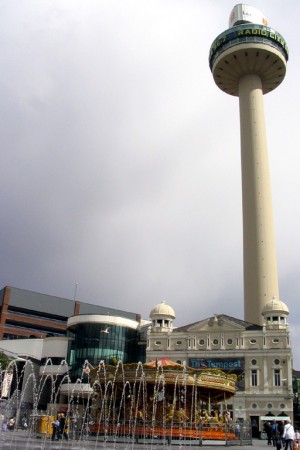Liverpool, UK
Radio City Tower, The Williamson Tunnels
While Liverpool’s main draw from a tourist standpoint is that The Beatles lived there, there is a wide variety on non-Fab Four things to see and do there. The best way to truly see and appreciate Liverpool is from above and below. From above, there’s no better vantage point than Radio City Tower. Originally called St. John’s Beacon, it was designed as a ventilation shaft for St. John’s Market and completed in 1969 (presumably John Lennon should have been able to see it from his house). Similar to structures such as Toronto’s CN Tower, The Space Needle in Seattle, Reunion Tower in Dallas and San Antonio’s Tower of the Americas, the tower featured a revolving restaurant and an outdoor observation deck. Eventually these were closed, and the platform at the top was occupied by Radio City 96.7. The tower had closed for renovation but was recently reopened for tours on weekends. It had been the tallest structure in Liverpool until being replaced by West Tower in 2008. West Tower features the Panoramic restaurant on the 34th floor with a commanding view, but be forewarned that dinner will probably run you the equivalent of front row tickets to a Paul McCartney concert, whereas Radio City Tower will only set you back about £6.25.
Just as fascinating as the liver bird’s view of Liverpool is the mole’s-eye view (if moles had decent eyesight). A trip to the Williamson Tunnels is called for to get a revealing look at what lies beneath Liverpool. The tunnels are historic, having been undertaken as a project by their namesake, tobacco magnate Joseph Williamson. Williamson was not born into wealth, but through hard work was able to amass a small fortune. At the turn of the 19th century he purchased land in an area of Liverpool called Edge Hill and in addition to constructing homes on the site, began the construction of a series of arched brick tunnels stretching for miles beneath the city. This eccentric behavior earned him the dubious title of the Mad Mole, but there was actually a benevolent purpose for the seemingly unnecessary tunnels. There was considerable unemployment in Liverpool at the time, and in order to provide workers with a job where they could earn a day’s wages with some dignity, he contracted them to build the tunnels (similar to Roosevelt’s Works Progress Administration, a program that would be a decent idea given the current economy).
After Williamson’s death in 1840, the tunnels were abandoned and largely forgotten, and many were filled with dirt, trash and debris. Occasionally local construction would break through a tunnel, or the chambers would fill with sewage and become a neighborhood nuisance, much like Clark Griswold’s cousin Eddie. In the 1990s, the area was set aside as a historic preservation site, and excavation of the tunnels began. Tours of the excavated areas are conducted from the restored Old Corporation stables above the tunnels. The stable yard was established in the mid-1800s for breeding horses used by the city for mail transport to hauling goods. Most of the horses had been phased out by 1960 and replaced by motorized vehicles; the Central Stables were finally closed in 1993. The tour starts through a set of barn doors where green hard hats are handed out. Either I have a gigantic head, or the helmets are designed for microcephalics, since mine rested atop my head making me look like my head was the object of a tortoise’s amorous desires. The tour guide stated that Williamson had never created a map of the tunnel system, and all of the vast maze of tunnels may never be uncovered. Scaffolding winds through the tunnels, affording insight as to how the tunnels were built. The tunnels are continuously being excavated, so the tour gets larger as new tunnels are uncovered. The entrance fee is reasonable, especially considering that the money helps go to the upkeep of the historic property and the tunnel excavation.
As with any city, the best way to get to know it is to see the high and mighty as well as the bottom of the rung in the underworld. Between is a myriad of sights, sounds, smells and tastes in the marvelous scouse stew that is the city of Liverpool.
Williamson Tunnels Heritage Centre
The Old Stableyard
Smithdown Lane
Edge Hill, Liverpool, L7 3EE, UK
GPS Coordinates: 53°24’14.20″N 2°57’30.46″W
Radio City Tower
St John’s Beacon
1 Houghton Street
Liverpool, Merseyside L1 1RL UK
GPS Coordinates: 53°24’22.21″N 2°58’55.29″W
Panoramic
West Tower
10 Brook Street
Liverpool, L3 9PJ, United Kingdom
GPS Coordinates: 53°24’35.50″N 2°59’48.07″W
See more pictures from Val’s visit Radio City Tower and the Williamson Tunnels in Liverpool




